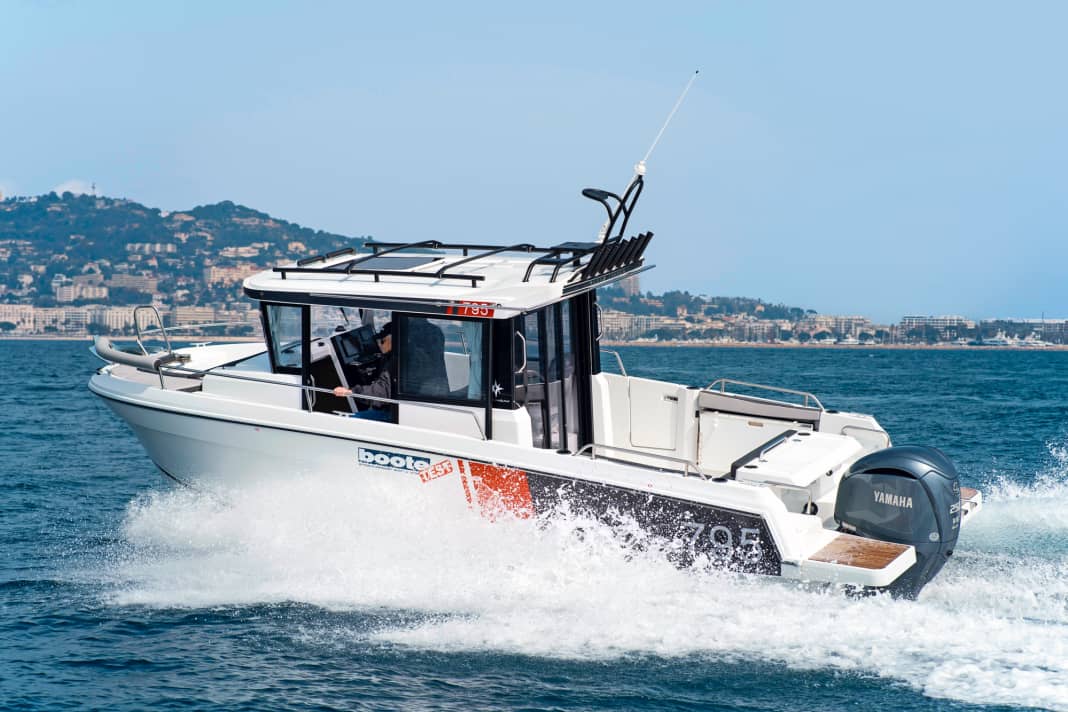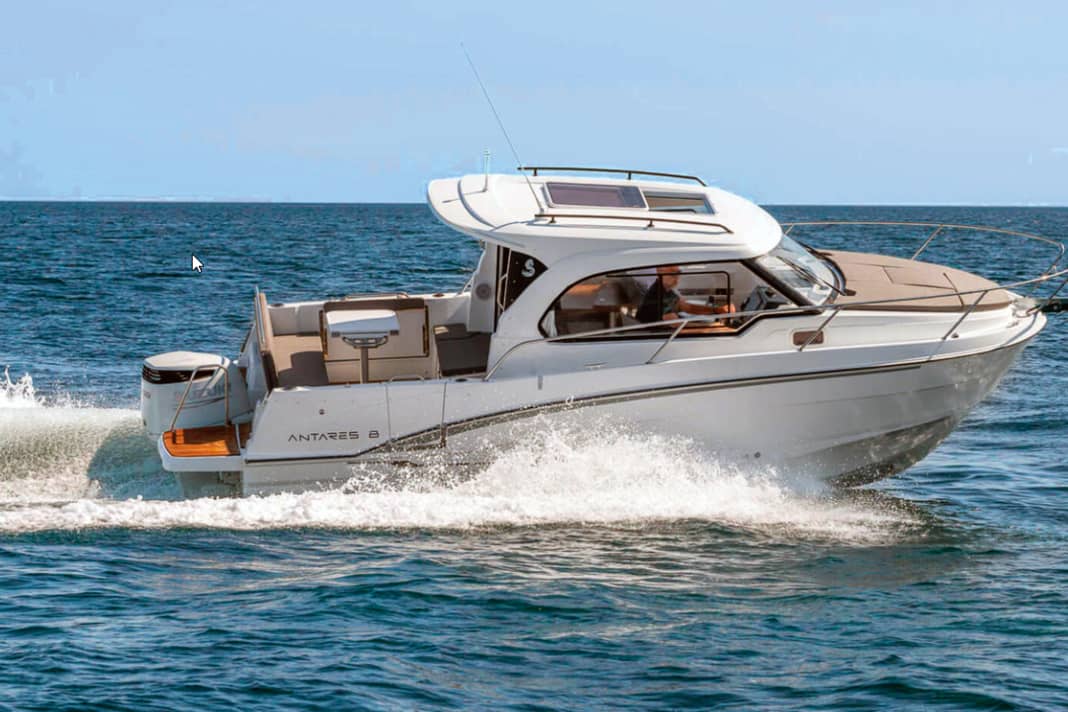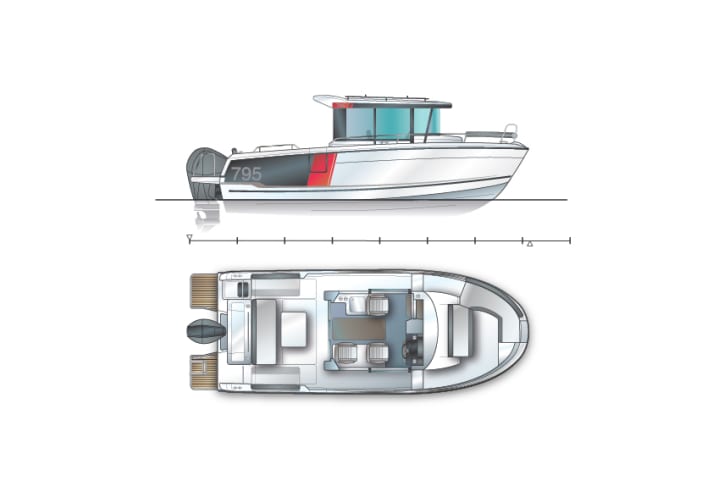





With the Merry Fisher 795, the name says it all, because with optional accessories such as fishing rod holders on the roof, fish boxes and an additional external driving position in the cockpit, there's hardly anything left to be desired for fishing enthusiasts. However, our sports model also has a number of other facets that enable versatile use. For example, for relaxed swimming and discovery tours with family and friends or sporty trips for water sports enthusiasts who enjoy kayaking or travelling with SUP boards or wing foils.
Jeanneau offers a very special roof rack for transporting water sports equipment, on which the equipment can be strapped down like in a car. The Merry Fisher is therefore a very versatile boat that can sleep up to four people, depending on the equipment.
Equipment options
Jeanneau offers a comprehensive list of accessories for outfitting. For example, you can have the forward cabin with a double berth and separate toilet room (like our test boat) or just a large berth without an extra toilet room. In the driver's cabin, there is the option of individual seats, a sink cabinet, refrigerator and rear exit (the two-door version) or a version with a rear bench without the aforementioned exit. For the cockpit, there are side benches that can be folded out or even a sun lounger. For the version with closed rear door, a cockpit galley (with sink and gas cooker) can be ordered directly behind the cab. A sunbed is also available for the foredeck, which can also be converted into a seating area. So there are plenty of options.
Back to our test boat: We enter it via the split bathing platform at the stern or via a side door on the starboard side (directly into the cockpit). It is also possible to access the foredeck via the bow. From there, the safest way into the cockpit is via the starboard side, as this side deck is wider than the other side. Solid handrails on both sides provide a secure hold, and anti-slip structures ensure slip resistance. A tubular frame sits on the side of the cabin roof, which can be extended aft and holds the bimini to protect it from too much sun.
Speaking of sun, a sunroof is installed in the cab so that the driver can also enjoy fresh air and sun from above (only when nothing is being transported on the roof, of course). The skipper sits on a sports bucket seat that can be swivelled. The same applies to the front passenger seat and the optional seat directly behind the driver. If you turn all three towards the centre, together with the table (on a bar), you create a fun three-person lap.
The competitors of theJeanneau Merry Fisher 795 Sport Série2




Driving and operation
From his seat - standing or sitting - the driver has a firm grip on the gearstick and rudder, he can easily read the instruments and operate the switches without any restrictions. The carpool looks through a safety glass window, the windscreen wiper on the passenger side of which costs extra. It is standard on the driver's side and gives the skipper an adequate field of vision. Advantage/disadvantage: The defroster nozzles in front of the windscreen ensure a clear view, although they cost extra together with the heater.
But now finally cast off and set off. On our test boat, this is done using hydraulic steering, electronic gear shifting and, if necessary, the bow thruster (optional). We let the Jeanneau sail towards the Mediterranean at around 5 knots and hardly had to intervene to correct the course; even weight shifts by one person had little effect on the course stability.
After the slow ride, we continue on the Mediterranean with a slight choppy sea. When accelerating with Yamaha's F250, the optional zip wake system helps us to keep the nose down. But even without the system, the Merry Fisher glides smoothly. At around 4000 rpm and just under 20 knots, she makes good progress, and at this speed we also calculate the most economical planing speed. With a fuel consumption of just under 2 litres per second, this results in a range of almost 120 nm, which is absolutely fine for this type of boat. We reach a maximum of 33 knots, then the range drops to just under 90 nm.

Noise level
With the doors closed, we measured a maximum of 86 dB/A at the helm. We then set off on the slalom course, where the Jeanneau swings easily from side to side and can be steered safely and easily with the hydraulic steering. When the rudder is torn away, the stern sets in softly and the hull continues to run straight ahead without swinging. In fast bends, the Jeanneau does not lean excessively on its side and remains stable even in moderate waves from the side, the propeller draws air at the end and Yamaha's V6 revs up. At this point, of course, you take the throttle off so as not to torture the engine unnecessarily. Rough water: The Jeanneau jumps safely and stably over the light choppy sea, coupled with waves from other sports boats.
Technology
The Yamaha outboard motor is expertly bolted to the solid transom and its cables run protected in an empty conduit to the onboard outlet. In the boat, some of the cables are also in the empty conduit, bundled together and secured with clamps. The edges of the openings are professionally protected against chafing. Further praise: The filter cartridge and stopcock are standard for the fuel supply - both are easy to reach, as are the main switches under the driver's seat. The associated batteries are safely stored in plastic boxes in a storage space under the cockpit floor. The bilge system also scores extra points, as it is well equipped with a manual bilge pump and electric bilge pump.
The concept of the Merry Fisher Sport is that everyone can put together their own boat. But for us, the extra equipment such as a signal horn, centre cleat and cushions for the standard benches are part of the standard boat equipment. There is a self-draining anchor locker in the bow for anchoring. An anchor package is included in the accessories list. The workmanship of the boat makes a neat, solid impression.
Conclusion
The Jeanneau 795 Sport Série2 is fun to sail and its extensive range of accessories allows you to customise your boat to your own requirements. The idea of the roof rack is of particular interest to active water sports enthusiasts with kayaks and boards. With the 250 hp Yamaha, it is safe but also agile when travelling. We also liked the complete bilge system and the fuel system with filter and stopcock.
Standard equipmentJeanneau Merry Fisher

Hydraulic steering; single lever gearstick; driver's seat; co-driver's seat; sink; cockpit bench seat; bow bench seat; lockers; bathing ladder; rubbing strake; hatch; 1x windscreen wiper; anti-slip coating; starter battery; main battery switch; electric bilge pump; hand bilge pump; handles/rails; windows; fuel shut-off valve, fuel filter, four stainless steel cleats; anchor locker; navigation lights; engine instruments; compass
Technical dataJeanneau Merry Fisher 795 Sport Série2
The boat
- Shipyard: Jeanneau/F
- Type: Merry Fisher 795 Sport Série2
- CE category: C/9 persons
- Hull and deck:Plastic
- Length over everything: 7,19 m
- Width: 2,79 m
- Displacement (without motor): 2177 kg
- Depth: about 0.80 m
- Clearance height: 2,36 m
- Fuel tank: 280 l
- Water tank: 100 l
- Holding tank: 80 l
- Berths: 2
- Bunk dimension: 1.30-1.60 x 1.90 m
- Standing height: Cabin 0.75 m-1.44 m; wet room 1.43 m, saloon 2.01 m; under sunroof 1.91 m
- Cockpit size: 1.83 m x 2.52 m
- Sunbeds: Foredeck 1.58 m x 1.48 m
- Freeboard: 0,81 m
- Interior cockpit side height: 0,76 m
- Turning circles (boat lengths):forwards tr. 1.5 bb. 1.5; backwards tr. 1, bb. 1
- Change from starboard to port:3-4 s
- from Bb. to Stb:3-4 s
- max. motorisation:Outboard engine 184 kW (250 hp)
- Test motorisation: 1x Yamaha F 250 184 kW (250 hp)
- Price (standard boat with test engine):99.138 €
- Dealer proof: www.jeanneau.de
The motor
- Manufacturer:Yamaha
- Type:F250 XCB
- Performance:184 kW/250 hp
- Full load speed:5000-6000 rpm
- Cylinder:V6
- cubic capacity:4169 cc
- Fuel:Petrol
- Cooling:Water/single circle
- Generator:12 V/70 A
- Gear ratio:1,75 : 1
- Test propeller:T15 Saltwater

